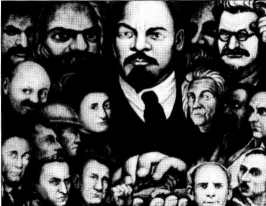
Rivera’s murals were overtly political
Reviews, Socialist Review, No.254, July 2001.
Copyright © Socialist Review.
Copied with thanks from the Socialist Review Archive at http://www.lpi.org.uk.
Marked up by Einde O’Callaghan for the Marxists’ Internet Archive.
Revolutionary Portraits
Various Authors
Redwords £4.99
 |
|
Rivera’s murals were overtly political |
The artistic is not the political. But there are important connections between the two. This is the message from these four excellent short new paperbacks from Redwords. Each shows that exploring the social and political background to an artist’s work can increase your appreciation of it enormously.
Paul McGarr writes about Mozart. He brings out the degree to which he was a child of the period known as the Enlightenment, that bridged the century between the end of revolutionary turmoil in England in 1688 and the beginning of revolutionary turmoil in France a century later. Mozart was one of a layer of middle class intellectuals who resented their own subordinate position in European society and who looked to reform from above to reorganise things along supposedly rational lines. This does not mean the music can simply be reduced to such social factors. It exists in its own right, as the result of a particularly talented individual using a preceding musical tradition to give vent to his own feelings as his life was shaped by these factors. And that enables it to connect with our feelings today.
What Paul McGarr does for Mozart, Martin Smith does for the American jazz saxophonist John Coltrane. In a fascinating study he shows how the successive stages in his work arise, on the one hand, from the technical development of jazz and, on the other, from the impact of the struggle against black oppression.
John Molyneux and Mike Gonzalez apply a similar approach to two very different visual artists. Molyneux’s study of Rembrandt explores the connections between his achievement as a painter and the fact that he lived in the first fully bourgeois society – Holland in the first half of the 17th century. Only in such a society, he argues, could Rembrandt’s art have developed as it did. This influenced how he painted and what he painted, and explains the contrast with predecessors and his contemporaries elsewhere in Europe.
Mike Gonzalez’s book on Diego Rivera differs from the other studies in one important respect – his is openly critical of certain aspects of his subject’s art. Rivera is probably the best known explicitly revolutionary visual artist of the 20th century. After making a career for himself as a relatively successful mainstream artist in Europe and an intimate of Picasso’s Cubist circle in the Paris of the First World War, he returned to his native Mexico in 1921 at the age of 35 and embarked upon a completely different approach to art. Instead of producing individual studies and portraits for sale to wealthy individuals, he joined with people like David Siquieros and José Clemente Orozco in producing murals of mammoth proportions with an explicitly revolutionary intent.
So Rivera shows the whole gamut of Mexican history from the conquest of the Aztecs by the Spanish to the 1930s, the struggles of workers and peasants, the festivals of the country’s indigenous people, life in the Ford motor company’s factories in Detroit, revolutionary fighters and even Marx, Lenin and Trotsky. To see them on the walls of Mexico’s public buildings is to be transfixed, and even in art book reproductions they are like little else you are likely to come across.
Yet Mike Gonzalez is critical of them despite this. For he argues – I think convincingly – Rivera had one great failing. His workers and peasants are shown as suffering, but never as shaping their own futures. As a result his murals can tell the story of the past or point to certain horrors in the present. But they fail to convey a genuinely revolutionary message, which is imposed on them from outside in a way that does damage to the art itself.
Gonzalez argues the failure arises from Rivera’s acceptance of a glorified view of the Mexican Revolution of 1910-20 – a revolution which ended with the murder of the most authentic revolutionary leader (Emiliano Zapata) and the establishment of a nationalist but unambiguously capitalist regime dressed up in revolutionary colours. As a result, Diego Rivera’s art is that of a revolutionary nationalist, despite its reference to Marx or Trotsky and his own adherence to the Communist Party and briefly to Trotskyism.
It is better, Gonzalez suggests, not to put a message of hope into art rather than to put in a false message that compromises its integrity. This leads him at points to suggest that Orozco, who was much less explicitly committed politically than Rivera, produced the better – and socially more relevant – art. On this I also agree with Gonzalez. Orozco’s work is virtually unknown in Britain, but his Carthasis or his Guadalajara mural of the Hidalgo, the leader of the first Mexican rising against the Spanish, have a power greater than anything by Rivera.
I strongly recommend all four books. They all show art can be socially relevant without degenerating into mere propaganda.
Last updated on 26 December 2009